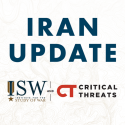Iran Update, March 19, 2025
Mar 19, 2025 - ISW Press
President Donald Trump’s March 5 letter to Iranian Supreme Leader Ali Khamenei set a two-month deadline to reach a new nuclear deal, according to an Axios report. Iran is very unlikely to agree to a new deal on a two-month timetable given its current policies on negotiations.










